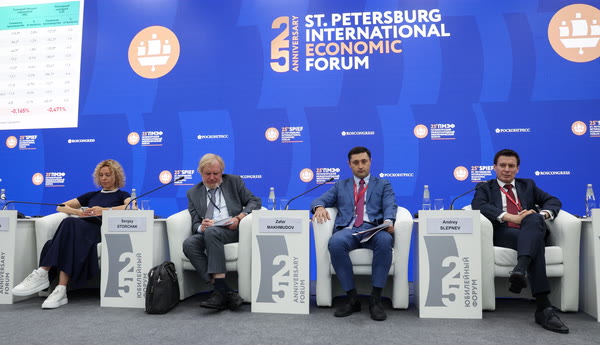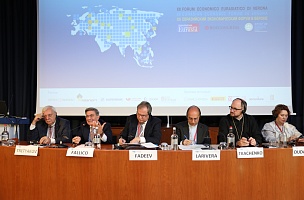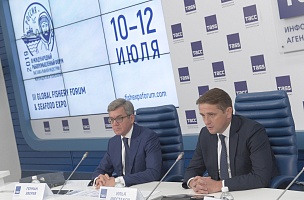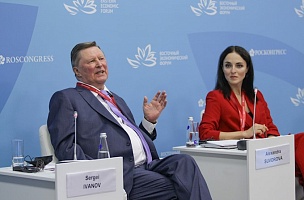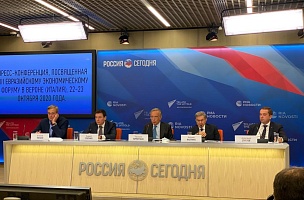KEY CONCLUSIONS
The importance of the climate agenda is clear, but requires the development of standards
“We still have the technological transition. And we need to figure out how to combine these two trends – the technological transition, which is based on climate logic and transformation, and the economic impact of the events taking place today. <...> We must be included in the main processes of the climate agenda, and understand that the emission commitments are made at the national level. <...> We are preparing a roadmap, we are discussing it now, and we hope that we will be able to adopt it this year. [It is] the functioning of the single market without restrictions. We know the situation with European border regulation, how it is assessed in terms of barriers. We all remember the introduction of fees after the accession of the Russian Federation to the WTO. There is a feeling that this could happen again,” Andrey Slepnev, Member of the Board, Minister in Charge of Trade, Eurasian Economic Commission.
Cooperation in new technological realities has significant potential
“We have to decide, we have remained one of the big markets that still hasn't voiced its opinion on cars with traditional internal combustion engines. Around us, almost everyone has decided, at least in terms of cars. We are still silent for now, but this is a serious [decision] for our car industry, which will still be overloaded, and some signals need to be developed,” Andrey Slepnev, Member of the Board, Minister in Charge of Trade, Eurasian Economic Commission.
“Cooperation has a significant potential in the light of today's events. I mean the cooperation of production in a new technological cycle, a new technological order. Of course, today we are discussing low-carbon transport and renewable energy programmes. Now everything should be reassessed with this as well. <...> There are a lot of interesting initiatives and practices that are already being implemented by businesses. We have created a sort of a bank of projects, more than a hundred of them already. These are not just fantasy projects, but ones that have already been implemented, created by serious companies. <…> There is a task of a large scale, we are discussing the financing of green projects, and we need to see what resources we have,” Andrey Slepnev, Member of the Board, Minister in Charge of Trade, Eurasian Economic Commission.
Russia in the new realities is ready to fulfill its obligations on carbon neutrality
“Global warming is a worldwide problem, and we will fulfill all the obligations that Russia assumed, including the ones assumed last year. Perhaps our plans are not as intense as those of our neighbours, although by 2030 we must reduce the volume of emissions of 1990 levels by 30%, by 2050 – by 80%, and by 2060 reach neutrality. <...> The goals are achievable, we do not plan to revise them. <…> Ecological well-being is the main thing we need,” Ilya Torosov, First Deputy Minister of Economic Development of the Russian Federation.
“We must create our own model of the global climate and the model of the climate of Russia, adaptation to climate observation, in order to speak the same language with our colleagues abroad. We need our own data, an understanding of how the climate is changing, how it affects sectors of the economy, and certain regions. <…> We are ready to spend more than RUB 10 billion on this by 2024,” Ilya Torosov, First Deputy Minister of Economic Development of the Russian Federation.
PROBLEMS
The introduction of a payment under the Carbon Border Adjustment Mechanism entails large payments for a number of countries, including Russia
“Our total payment estimates [for Russia – Ed.] for CBAM [Carbon Border Adjustment Mechanism – Ed.] range from 40 billion to 110 billion euros over 10 years. <...> The introduction of the EU CBAM will lead to a decrease in Russian GDP from 0.2 to 0.5 according to a negative scenario. Our estimates show that starting from 2026 Russia’s payment will be about one billion euros; for Belarus the payment will be 25 million; for Kazakhstan – 11; for Uzbekistan – 7; for Armenia – about one million euros,” Samvel Lazarian, Head of the Centre for Macroeconomic Research, Financial Research Institute of the Ministry of Finance of the Russian Federation.
“In the case of the worst-case scenario that we expect after 2030, the estimate of payments for some countries will increase tenfold. <…> We expect that regulation parameters in Asia may not be weaker than in the EU. We see that the requirements on the Asian exchanges are now largely comparable to those in the EU. <...> As a result, we expect China's demands to be at least the same, and possibly tougher,” Samvel Lazarian, Head of the Centre for Macroeconomic Research, Financial Research Institute of the Ministry of Finance of the Russian Federation.
It is necessary to develop common principles of green taxonomy and green financing
“It is necessary to develop common principles of green taxonomy. Some countries are developing their own taxonomy now. <...> We need to think about the effectiveness of green financing. Here, we need to talk about the convergence of guidelines and strategies. <...> It is necessary to understand that the solution of the climate problem very often conflicts with the goals of economic growth, which is relevant for our region. Overall, to achieve carbon neutrality, the carbon intensity of GDP must decline five times faster than it has been in the past 20 years,” Samvel Lazarian, Head of the Centre for Macroeconomic Research, Financial Research Institute of the Ministry of Finance of the Russian Federation.
The use of simple energy-saving technologies has a positive effect on the climate
“There are no super-new technologies here, <…> even not very high technologies give a very noticeable effect when applied. There is no need to chase after something high, but to implement something fairly average, affordable, and this really changes the situation in terms of climate impact,” Andrey Sharonov, Chief Executive Officer, National ESG-Alliance.
“The volume of green financing that Sberbank implemented in 2021 and continues to implement this year: last year we issued 25 billion green bonds, they were used to refinance renewable energy sources. And last year we finished with a portfolio of RUB 306 billion in green loans. And as of 1 June, this amount is RUB 395 billion, which indicates that funding continues. These are not new projects, these are projects that have been launched before. And we see this as a great demand, great opportunities on the market side,” Tatiana Zavyalova, Senior Vice President for ESG, Sberbank.
Conditions have been created in the EAEU space for the formation of an ESG infrastructure
“How do we assess the development, ESG dynamics in the EAEU? In 2021, financial instruments were issued on the territory of the EAEU in the amount of RUB 250 billion, which is a multiple higher than in the previous period. According to the European Bank for Reconstruction and Development, the EAEU countries and Tajikistan need to invest more than USD 550 billion in decarbonization by 2030, that is, almost USD 70 billion annually. It seems that in order to attract them and operate them effectively, it would be right to think about creating a unified ESG infrastructure in our common space. I think that we are practically ready for this; the infrastructure in Russia is almost ready and will begin to operate in full starting from the beginning of 2023. Kazakhstan has progressive solutions that are already functioning, and there are great developments in other countries,” Tatiana Zavyalova, Senior Vice President for ESG, Sberbank.
For more information, visit the Roscongress Foundation’s Information and Analytical System at roscongress.org/en


